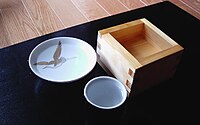
Photo from wikipedia
Forage preservation for livestock feeding is usually done by drying the plant material and storing it as hay or ensiling it into silage. During the ensiling process, the pH in… Click to show full abstract
Forage preservation for livestock feeding is usually done by drying the plant material and storing it as hay or ensiling it into silage. During the ensiling process, the pH in the system is lowered by the activities of lactic acid-producing bacteria (LAB), inhibiting the growth of spoilage microorganisms and maintaining the quality of the ensiled product. To improve this process, inoculation of LAB could be used as starter cultures to shorten the ensiling time and control the fermentation process. Here, we compared fermentation quality and bacterial dynamics in two plant materials, whole-plant corn (Zea mays L.) and Napier grass (Pennisetum purpureum), with and without starter inoculation. The efficacy of Lactobacillus plantarum, L. brevis, and Pediococcus pentosaceus as starter cultures were also compared in the ensiling system. In whole-plant corn, pH decreased significantly, while lactic acid content increased significantly on Day 3 in both the non-inoculated and LAB-inoculated groups. Prior to ensiling, the predominant LAB bacteria were Weissella, Enterococcus, and Lactococcus, which shifted to Lactobacillus during ensiling of whole-plant corn in both the non-inoculated and LAB inoculated groups. Interestingly, the epiphytic LAB associated with Napier grass were much lower than those of whole-plant corn before ensiling. Consequently, the fermentation quality of Napier grass was improved by the addition of LAB inoculants, especially L. plantarum and a combination of all three selected LAB strains showed better fermentation quality than the non-inoculated control. Therefore, the different abundance and diversity of epiphytic LAB in plant raw materials could be one of the most important factors determining whether LAB starter cultures would be necessary for silage fermentation.
Journal Title: Frontiers in Microbiology
Year Published: 2022
Link to full text (if available)
Share on Social Media: Sign Up to like & get
recommendations!